Domesday
In the Domesday Book of 1086 the name of the parish is written as Bluneham. The parish has three separate entries in the book. The Abbey of Bury Saint Edmunds held 4¼ hides. The holding included 8 villagers, 5 smallholders and 1 slave. It included a mill and the whole was worth £6 in 1066, 70 shillings when acquired and £4 at Domesday, the lesser values the result of plundering by soldiers of William I's army moving north to quell rebellion. In 1066 four Freemen had held the land.
Eudo, son of Hubert also held a virgate in Blunham, Dominic being his tenant, again four Freemen had held this in 1066 when it was worth 5/- which declined to 3/- when acquired and 2/- in 1086. The final mention in the Domesday Book is of half a hide held by the Abbey of Bury Saint Edmunds from its overlord, the Countess Judith. This had been worth £1 in 1066m declining to 10/- when acquired, but rising back to its original figure by 1086.
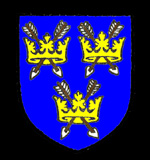
The coat of arms of Saint Edmund's Abbey
Blunham Manor
The Victoria County History for Bedfordshire, published in 1910 gave brief histories of all the manors in the county. The Overlordship of Blunham Manor remained in the hands of the Abbey of Bury Saint Edmunds from the time of the Domesday Book until the Reformation, the abbey being dissolved in 1539. After that the overlordship ceased to exist.
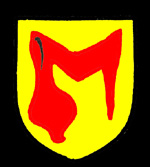
Hastings family coat of arms
No tenant of the abbey's 4½ hides is mentioned in Domesday Book but it is known that William I (1066-1087) granted it to a man named Ralph for the service of a steward for Bury Abbey. King Stephen (1135-1154) granted tenancy of the manor to a man named Maurice de Windsor and his nephew, Ralph de Hastings held the manor during the reign of Henry II (1154-1189). He was followed by his nephew William Hastings, who died in 1182 and was followed by his son Henry, then a minor. Henry Hastings died in 1196 and his brother William succeeded him. The Hastings family was an important one. Henry Hastings became Baron Bergavenny [Abergavenny] in 1273 and in 1339 Lawrence Hastings became Earl of Pembroke.
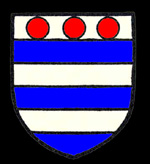
De Grey family coat of arms
The last Hastings to hold the manor was John Hastings who died in 1389, when the manor passed to his cousin and heir Reginald de Grey of Ruthyn. The Greys were another powerful family, becoming Earls of Kent in 1465. The Greys held the manor until the death of Henry Grey, Lord Chamberlain, Lord Steward and Lord Privy Seal who became Duke of Kent in 1710. On his death in 1740 his heir was his granddaughter Jemima, daughter of the Duke's daughter Amabel. Jemima married Philip Yorke, Earl of Hardwicke and was Baron Lucas of Crudwell and Marquess de Grey in her own right. She died in 1797 and her elder daughter, wife of Viscount Polwarth inherited Blunham Manor as well as the Barony Lucas of Crudwell, the title Marquess de Grey becoming extinct. She was created Countess de Grey of Wrest in 1816 and on her death in 1833 her titles and lands passed to her nephew Thomas Philip Weddell. He died in 1859 and his elder daughter Anne, Lady Lucas inherited the manor. She married Earl Cowper and was succeeded in 1880 by her son Francis Thomas de Grey who died in 1905, the manor passing to his trustees. In the 1920s a succession of Law of Property Acts abolished copyhold tenure and manorial fines and incidents and thus abolishing the concept of manors themselves in all but name.
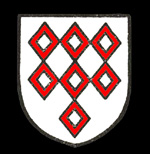
The Braybrooke family coat of arms
Blunham Manor
A second Blunham Manor originated in land held by the Braybrooke family from the overlord, the Earl of Pembroke [see above]. In the 13th century John de Braybrooke claimed some rents in Blunham and his descendant Gerard, who died 1359 held land in the parish worth £7. His son, another Gerard obtained a grant of lands in Blunham in 1425. He died in 1427 and his cousin and executor Reginald Kentwode, Dean of Saint Paul's granted the manor to Sir William Beauchamp and his wife Elizabeth, Gerard's daughter.
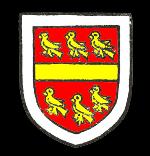
The Beauchamp family coat of arms
A manorial court is mentioned in records in 1430 and 1446. William Beauchamp was later created Baron Saint Amand and died in 1457 when his son Richard succeeded him. Richard was dispossessed by Richard III in 1483 for plotting on behalf of Henry Tudor and the manor given to Lord Stanley and his son. This was reversed when Henry Tudor usurped the throne, as Henry VII, after killing Richard III at Bosworth Field in 1485. In 1491, on her death, Elizabeth Saint Amand, widow of Sir Roger Tocotes held this Blunham Manor from the Earl of Kent. Her son Richard Beauchamp succeeded. He died in 1508 when the Saint Amand title became extinct. For some years the manor was in the hands of the trustees of the last Lord Saint Amand. The manor is last recorded in 1534 when Saint John's College, Cambridge agreed, after a long dispute to pay George, Lord Cobham, a tithe for it.